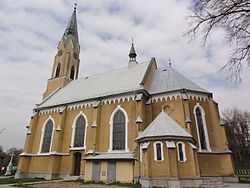| Mazańcowice | |
|---|---|
| Village | |
 Saint Mary Magdalene Church Saint Mary Magdalene Church | |
 Coat of arms Coat of arms | |
 | |
| Coordinates: 49°51′25.4″N 18°58′45.6″E / 49.857056°N 18.979333°E / 49.857056; 18.979333 | |
| Country | |
| Voivodeship | Silesian |
| County | Bielsko |
| Gmina | Jasienica |
| First mentioned | 1305 |
| Government | |
| • Mayor | Jan Zawada |
| Area | |
| • Total | 8.18 km (3.16 sq mi) |
| Population | |
| • Total | 3,745 |
| • Density | 460/km (1,200/sq mi) |
| Time zone | UTC+1 (CET) |
| • Summer (DST) | UTC+2 (CEST) |
| Postal code | 43-391 |
| Car plates | SBI |
Mazańcowice is a village in Gmina Jasienica, Bielsko County, Silesian Voivodeship, southern Poland. It lies in the historical region of Cieszyn Silesia.
The name of the village is derived from personal name Mazaniec (Mazanek). The name was first recorded (1305) with a typical Slavic ending -itcz (-ice), then it was also mentioned with a typical German ending -dorf (Mazanczendorff, 1452 and Matzdorff in 1566).
History

The village was first mentioned in a Latin document of Diocese of Wrocław called Liber fundationis episcopatus Vratislaviensis from around 1305 as item in Mansanczovitcz. It meant that the village was in the process of location (the size of land to pay a tithe from was not yet precised). The creation of the village was a part of a larger settlement campaign taking place in the late 13th century on the territory of what will be later known as Upper Silesia.
Politically the village belonged initially to the Duchy of Teschen, formed in 1290 in the process of feudal fragmentation of Poland and was ruled by a local branch of Piast dynasty. In 1327 the duchy became a fee of Kingdom of Bohemia, which after 1526 became part of the Habsburg monarchy. In 1572 it became a part of Bielsko state country, in 1754 elevated to Duchy of Bielsko.
After Revolutions of 1848 in the Austrian Empire a modern municipal division was introduced in the re-established Austrian Silesia. The village as a municipality was subscribed to the political and legal district of Bielsko. According to the censuses conducted in 1880, 1890, 1900 and 1910 the population of the municipality grew from 1522 in 1880 to 1583 in 1910 with a majority being native Polish-speakers (at least 90.8% in 1910, at most 96.6% in 1890) accompanied by a German-speaking minority (at most 144 or 9.1% in 1910). In terms of religion in 1910 majority were Roman Catholics (66.8%), followed by Protestants (32.9) and Jews (5 people).
After World War I, fall of Austria-Hungary, Polish–Czechoslovak War and the division of Cieszyn Silesia in 1920, it became a part of Poland. It was then annexed by Nazi Germany at the beginning of World War II. After the war it was restored to Poland.
Landmarks
There is a Catholic Mary Magdalene Church and also a Lutheran church in the village.
Footnotes
- ^ Mrózek, Robert (1984). Nazwy miejscowe dawnego Śląska Cieszyńskiego [Local names of former Cieszyn Silesia] (in Polish). Katowice: Uniwersytet Śląski w Katowicach. p. 115. ISSN 0208-6336.
- Panic, Idzi (2010). Śląsk Cieszyński w średniowieczu (do 1528) [Cieszyn Silesia in the Middle Ages (until 1528)] (in Polish). Cieszyn: Starostwo Powiatowe w Cieszynie. pp. 297–299. ISBN 978-83-926929-3-5.
- Schulte, Wilhelm (1889). Codex Diplomaticus Silesiae T.14 Liber Fundationis Episcopatus Vratislaviensis (in German). Breslau.
{{cite book}}: CS1 maint: location missing publisher (link) - "Liber fundationis episcopatus Vratislaviensis" (in Latin). Retrieved 13 July 2014.
- Piątkowski, Kazimierz (1918). Stosunki narodowościowe w Księstwie Cieszyńskiem (in Polish). Cieszyn: Macierz Szkolna Księstwa Cieszyńskiego. pp. 258, 276.
References
- Polak, Jerzy (2011). Obrazki z dziejów gminy Jasienica. Cieszyn: Muzeum Śląska Cieszyńskiego. ISBN 978-83-922005-6-7.
- Londzin, Józef (1932). Kościoły drewniane na Śląsku Cieszyńskim. Cieszyn: Dziedzictwo błog. Jana Sarkandra. pp. 192–196. OCLC 297540848.
External links
- (in Polish) Information at Gmina Jasienica website
| Gmina Jasienica | ||
|---|---|---|
| Seat: Jasienica | ||
| Other villages | ||

